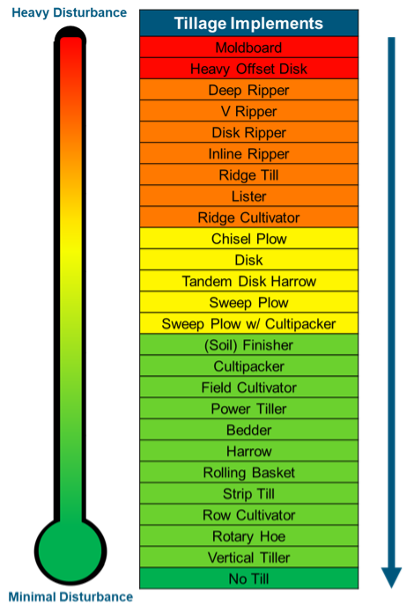What tillage practice changes qualify for carbon credits
ARTICLE SUMMARY: Explore tillage practice changes, including what qualifies, agronomic benefits, and carbon credit potential.
A change to tillage practices is a great way to earn carbon credits and has immense agronomic benefits. There are three different ways to adjust your tillage practice and our team of carbon farming experts is here to help choose which ones are right for your operation.
The three tillage practice changes are:
- Tillage reduction through the number of passes
- Tillage reduction through delayed tilling
- Tillage implement change to lower intensity
1. Tillage reduction through the number of passes
Practice change: Reduce the total number of tillage passes on a field between harvest and the next cash crop planting. This includes a reduction to no-till (i.e., 0 tillage passes).
Examples of qualifying scenarios: Following soybeans, a grower used to make a single fall tillage pass and two spring tillage passes. They change to a single spring pass. The total tillage passes drop from 3 to 1, this is a qualifying change. Note: Reducing the number of passes requires a full pass reduction based on the average of your historical tillage.
Agronomic benefits: Fewer tillage passes can help reduce soil disturbance, which leads to better soil structure, soil pores, and soil organic matter. This helps increase carbon sequestration rates, water infiltration, water storage, and soil carrying capacity.
Recommendation: To have a greater positive impact on soil health and reduce oxidation, try to combine tillage pass reductions with extending the time between the first tillage event to the next.
2. Tillage reduction through delayed tilling
Practice change: Delay tillage after harvest by at least 90 days from what has been historically practiced on that field and crop.
Examples of qualifying scenarios: Following soybeans, a grower used to make a single fall tillage pass and one spring tillage pass. They move to two spring passes and eliminate the fall tillage. In this example, the grower delays their tillage from fall to spring without increasing the total number of tillage passes.
Agronomic benefits: Delaying tillage after harvest, without increasing the total number of passes, gives soil more time to develop soil structure. Soil structure and soil pore formation are both vital drivers of soil microbial activity. When soils are left undisturbed, they can maximize soil structure and increase soil microbial activity.
Recommendation: Delaying tillage after harvest for greater than 90 days allows those soil ecosystem functions to continue longer and increases soil organic matter and soil organic carbon levels.
3. Tillage implement change
Practice change: Move a single tillage pass from a higher disturbance class of implement to a lower soil disturbance class of implement.
Examples of qualifying scenarios: If a grower uses an inline ripper and changes to a rolling basket, it qualifies. Note: Dramatically reducing tillage (deep till to no-till) isn’t eligible, as the shock to the system can have unintended carbon impacts. Specifically, moldboard plow to no-till and heavy offset disc to no-till don’t count. In those situations, it is best to step down to reduced tillage for a couple of years.
Agronomic benefits: Using lower disturbance implements reduces soil disturbance and better protects soil structure.
Recommendation: The bigger the practice change, the higher the credit generation potential. The biggest change that can be done is deep ripper to no-till. Remember: Moldboard plow to no-till and heavy offset disc to no-till are both ineligible.

We’re in it to win it, together.
Tillage changes have a high credit generation in the long run, but it takes a few years for soil to adjust to the change and be able to store carbon. The prices for carbon credits are predicted to increase to $80/credit by 2030. If you start incorporating tillage practice changes today, you can build up soil organic carbon in time to benefit from high credit prices.


